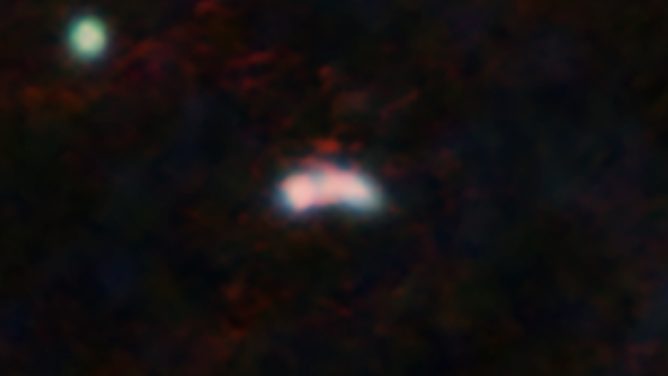2022.03.02
ALMA detects nitrogen and oxygen radio waves emitted by a galaxy 12.9 billion years ago

Artist’s impression of a 12.9 billion year old galaxy, from which nitrogen and oxygen were successfully detected. Due to the gravity of the galaxy in the foreground (orange), the galaxy behind is observed as two arc-shaped objects.
Credit: ALMA (ESO/NAOJ/NRAO)
Nitrogen and oxygen, which make up approximately 99% of the Earth’s atmosphere, did not exist immediately after the Big Bang, which occurred 13.8 billion years ago. They were created by the fusion reaction inside a star. Elements heavier than helium (called “heavy elements”) such as nitrogen and oxygen were produced and released into the interstellar space by the explosion and stellar wind at the end of the star’s life. Subsequent new stars were born from the gas containing heavy elements, and the fraction of heavy elements in the universe has increased over time due to the repetition of this process.

ALMA image of a galaxy called G09.83808 that existed 12.9 billion years ago. Due to the gravity of the galaxy in the foreground, it is observed as a two arc-shaped object.
Credit: ALMA (ESO/NAOJ/NRAO), HSC-SSP, Tadaki et al.
Although the same fusion reaction resulted in nitrogen and oxygen, their origins are thought to be slightly different. Oxygen was created from helium inside the short-lived stars, which existed shortly after the Big Bang. Therefore, oxygen was likely already present in the early universe. On the other hand, most nitrogen was produced by a chain of fusion reactions containing carbon and oxygen inside a relatively long-lived star. Therefore, researchers believe that nitrogen came into existence later than oxygen. Moreover, the detection of nitrogen emitted by a galaxy 12.9 billion years ago suggests that stars have born and died repeatedly to produce heavy elements even before that.
To understand the evolution of galaxies during the 13.8-billion-year history of the universe, it is important to observe galaxies at various times and examine the amounts of heavy elements. While several recent studies have reported the detection of oxygen in galaxies in the early universe, nitrogen was barely detected owing to its weak signal.
In this study, by using the highly sensitive ALMA and the natural amplification effect by gravitational lenses, the team successfully captured radio waves of oxygen and nitrogen, as well as carbon monoxide and dust, from a galaxy that existed 12.9 billion years ago. The image captured by ALMA is split into two arc-shaped objects created due to the gravitational influence of the foreground galaxy. Stronger radio emission of nitrogen than oxygen implies a large abundance of heavy elements due to multiple generations of birth and the death of stars. Assuming that the empirical laws in the present universe hold true in the early universe, the observed nitrogen-oxygen intensity ratio suggests that approximately 50–70% of the heavy elements in the current solar system were already present 12.9 billion years ago.
The galaxy observed in this study is likely the ancestor of a giant elliptical galaxy with a larger mass and older stars than the Milky Way galaxy, where our solar system is located. How did the heavy elements in the galaxy increase in only 900 million years, where only hydrogen and helium existed immediately after the Big Bang? To answer this question, we need to observe and detect nitrogen and oxygen in a galaxy that was formed earlier than G09.83808. Future ALMA observations will hopefully clarify this question.
The results of this research will be published in “Publications of the Astronomical Society of Japan” by the Astronomical Society of Japan under the title, “Detection of nitrogen and oxygen in a galaxy at the end of reionization” by Tadaki et al.
This study was also presented as “ALMA observations of a submillimeter galaxy at z = 6 I: Detection of nitrogen” at the 2022 Spring Annual Meeting, Astronomical Society of Japan, which was held online from March 1, 2022”









